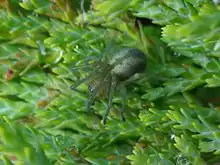Cheiracanthium erraticum
Cheiracanthium erraticum, the two-clawed hunting spider,[2] is a species of Palearctic spider of the family Cheiracanthiidae.[1]
| Cheiracanthium erraticum | |
|---|---|
 | |
| Scientific classification | |
| Kingdom: | Animalia |
| Phylum: | Arthropoda |
| Subphylum: | Chelicerata |
| Class: | Arachnida |
| Order: | Araneae |
| Infraorder: | Araneomorphae |
| Family: | Cheiracanthiidae |
| Genus: | Cheiracanthium |
| Species: | C. erraticum |
| Binomial name | |
| Cheiracanthium erraticum (Walckenaer, 1802)[1] | |
| Synonyms[1] | |
| |
Description
Females have a body length of 8–9 mm, males 5-6.5mm.[3] C. erraticum is a distinctively marked spider which shows a wide dark red stripe running down the centre of the abdomen, which is in turn surrounded by an area of creamy-yellow while the head is a reddish brown.[4]
Distribution
The species has a Palearctic distribution, from Ireland to east Asia.[1][3]
Habitat
This species favours the herbaceous layer and low bush layer of open habitats,[3] such as rough heather.[5] In Britain the altitudinal range is from sea level to 700 m.[5]
Biology
In early summer C. erraticum builds a retreat made from two or three leaves or grass heads which are stitched together to hold the female and her egg sac. Later in the year, the immature spiders, which are already showing the reddish median stripe on the abdomen, can be found in small silk cells on plant stems. Adult males are encountered mostly in late spring and early summer while the adult females are mostly found from late spring to the autumn.[5]
The spider wasp Homonotus sanguinolentus is a rare species which is wholly dependent on Cheiracanthium spiders and in Britain is wholly dependent on C. erraticum.[6] The ichneumonid wasp Schizopyga podagrica is another parasitoid of C. erraticum.[7]
References
- "Cheiracanthium erraticum (Walckenaer, 1802)". Natural History Museum Bern. Retrieved 7 September 2016.
- "Cheiracanthium erraticum (Walckenaer, 1802)". Universidade dos Açores. Retrieved 7 September 2016.
- "Cheiracanthium erraticum (Walckenaer, 1802)". Nentwig W, Blick T, Gloor D, Hänggi A, Kropf C: Spiders of Europe. www.araneae.unibe.ch. Retrieved 7 September 2016.
- "Cheiracanthium erraticum - Cheiracanthium erraticum". NatureSpot. Retrieved 7 September 2016.
- "Summary for Cheiracanthium erraticum (Araneae)". British Arachnological Society. Retrieved 7 September 2016.
- "Homonotus sanguinolentus (Fabricius,1793)". Bees Wasps & Ants Recording Society. Retrieved 7 September 2016.
- "Cheiracanthium erraticum (Walckenaer 1802) (Family Clubionidae)". J.K. Lindsey. Retrieved 7 September 2016.